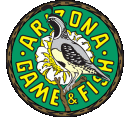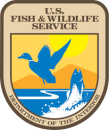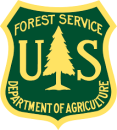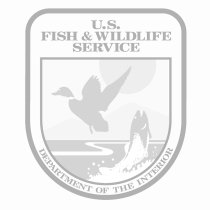Location
States
ArizonaEcosystem
River/streamIntroduction
The Frog & Fish Restoration Outreach Group (FROG) Conservation Project was an interdisciplinary, multi-organization partnership that sought to restore habitats and reintroduce threatened and endangered aquatic species in the Cienega Creek watershed of southeastern Arizona from 2010-2013. The FROG Conservation Project ended with NFWF funding in 2013, however the Cienega Watershed Partnership continued using the FROG moniker (hereafter referred to as the FROG project in this Case Study) from 2014-2019. Cienega Creek is fed by mountain ranges that drain into expansive semidesert grasslands and the riparian riparian
Definition of riparian habitat or riparian areas.
Learn more about riparian corridor. The watershed harbors the most ecologically intact cienega complex (valley wetland spring system) in the southwestern United States. This area includes lands managed by the Bureau of Land Management (BLM), U.S. Forest Service (USFS), Pima County, the Department of Defense, the state of Arizona, and numerous private landowners.
Cienega Creek is largely protected within the Las Cienegas National Conservation Area (LCNCA), established in 2000 by BLM, and the Cienega Creek Natural Preserve, managed by Pima County. In addition to high riparian bird diversity, including the endangered southwestern willow flycatcher (Empidonax traillii extimus), it hosts a diversity of riparian associated reptiles and amphibians, including the declining lowland leopard frog (Lithobates yavapaiensis), threatened Chiricahua leopard frog (Lithobates (=Rana) chiricahuensis) and Mexican gartersnake (Thamnophis eques), and three native fish species, including the endangered Gila Chub (Gila intermedia) and Gila Topminnow (Poeciliopsis occidentalis). The creek’s physical isolation and small size have largely protected it against non-native aquatic species establishment. The aquatic habitat is complex, but its size and isolation means that American bullfrog (Ranacatesbeiana) eradication is more feasible compared with larger, more interconnected waters elsewhere in the southwestern United States.
Key Issues Addressed
In arid regions around the world, wetlands and the aquatic vertebrates they support are among the most globally threatened ecological assemblages due to water extraction, drought, habitat modification, and invasive species invasive species
An invasive species is any plant or animal that has spread or been introduced into a new area where they are, or could, cause harm to the environment, economy, or human, animal, or plant health. Their unwelcome presence can destroy ecosystems and cost millions of dollars.
Learn more about invasive species . The American bullfrog is a highly invasive species that was introduced to the Cienega Creek watershed in the mid 1980s. It is strongly associated with extirpations of the federally threatened Chiricahua leopard frog (CLF) due primarily to predation and disease transmission, especially Chytridiomycosis, a disease caused by a fungal pathogen causing global amphibian declines. Though bullfrogs are not known to be affected by the pathogen, they are able to carry and spread the disease. Additionally, northern crayfish and several non-native fishes exist in areas adjacent to Cienega Creek. Potential invasion by these species could impede conservation and reintroduction of CLF.
Project Goals
- Quantify the abundance and distribution of native frogs, non-native bullfrogs, and other native aquatic species in Cienega Creek
- Eradicate non-native aquatic species in ten study sites between 2014 and 2019
- Improve CLF habitat conditions and establish additional populations
- Engage the public in aquatic conservation through outreach and education
Project Highlights
- Landscape Scale: The FROG project expanded on preliminary successes in 2010 and operated on a watershed level across jurisdictions from 2013 to 2019--this scale allowed the project to incorporate and observe metapopulation connectivity dynamics of both native and invasive aquatic species. Leopard frogs moved on average 7.43km straight-line distance, demonstrating large-scale metapopulation dynamics. Based on CLF recaptures within the system, project members recorded the longest documented movement for this species (15.13km), the longest documented movement for this species.
- Successful Non-Native Bullfrog Eradication: Bullfrog populations were successfully eradicated from the Cienega Creek complex in 2013. CLF quickly responded with successful establishment and population growth, supplemented by CLF captive rearing at the Phoenix Zoo and release into the Cienega Creek sites, as well as wild to wild CLF translocations.
- Designation of“Buffer-Zones” for Non-Native Species Detection and Removal: The project team established a buffer-zone, a swath of land in Sonoita, Arizona east along Highway 82 to the Mustang Mountains to prevent bullfrog dispersal from the nearby Elgin/Babocomari Valley. In 2013, University of Arizona scientists began monitoring a network of stock tanks annually within the buffer zone and removed any bullfrogs to prevent re-invasion from outside the buffer zone. Arizona Game and Fish Department (AGFD) biologists joined monitoring efforts in 2015 to expand monitoring efforts. USFS and the Appleton-Whittell Research Ranch personnel have also assisted with bullfrog removal from project sites.
- Chiricahua Leopard Frog Establishment: Partners raised and released 4,769 CLF to 10 new sites in the project area. Project members expanded the reintroduction area from seven breeding sites covering 42 square kilometers in 2013 to 19 sites over 84 square kilometers as of 2019. Biologists evaluated temperature characteristics to guide site selection for CLF reintroductions to mitigate the negative impacts of chytrid. As of 2019, CLF are found in 24 sites across the management area including in all wet sites on LCNCA, and several sites in Pima County and private lands east of LCNCA. Six of these 24 sites are active breeding sites for CLF. Additionally, dispersal of CLF among sites and seemingly between the LCNCA and the nearby Santa Ritas suggests CLF are now established. However, there is high mortality of adult frogs from disease at the constructed ponds. When chytrid is an issue for CLF, spring-stream sites appear to have higher adult survival overwinter, or less of a negative impact than in constructed ponds.
- Evaluating Chytrid Prevalence: Bullfrogs collected from both lentic and lotic sites in spring and fall (2014-2016) were swabbed and sent to the Amphibian Disease Laboratory, San Diego Zoo Institute for Conservation Research to evaluate for the chytrid disease. Water samples to check for environmental DNA (eDNA) of leopard frogs and chytrid fungus were collected and sent to Washington State University.
- Mutual Human-Ecological Benefits: Researchers built enduring working relationships with ranchers to establish water infrastructure for livestock, threatened frogs, endangered fishes and area wildlife. Visit this CART Case Study for more information on working with a local rancher in the Cienega Watershed
- Public Outreach: The FROG project was able to involve and educate residents in the Cienega Creek Watershed area on the importance of aquatic conservation through creating educational programs for local schools, environmental outreach programs, attending local meeting forums, tabling at area events and the development of a website.
- Federal Recognition: The project was awarded the 2013 Secretarial Partners in Conservation Award by the U.S. Department of Interior.
- Non-Native Aquatics Treatment Options: Bullfrogs were detected and counted to determine relative abundance via Visual Encounter Surveys (VES), with 558 surveys conducted by the FROG project attempted at least once a month from 2014 through summer 2019. Bullfrogs were removed from targeted sites through various treatment methods including draining ponds and cattle tanks, shooting with .22 rifles, and dip and seine netting. Northern crayfish (Orenectes virilis) were removed from Clyne pond through draining and chemical treatments with Rotenone from 2007-2009. Drying and chemical treatments were not feasible at Clyne Spring. Instead, the small spring was trapped from 2011 to 2017 using up to 10 minnow traps deployed at a time baited with “Gravy Train” brand dog kibble. For more detailed information on bullfrog eradication methods used in southern Arizona visit this CART Case Study.
Lessons Learned
Habitat Restoration: Enhanced and converted livestock waters now provide permanent, drought-proof water for native fish and wildlife in addition to Chiricahua leopard frogs.
- Eradicating Bullfrogs: Bullfrog eradication in Cienega Creek required intensive, early-season removal of adults and juveniles to prevent breeding and dispersal in the summer. Fine-mesh hoop traps were effective in capturing tadpoles, while shooting with 22-caliber rifles was most effective in collecting adult frogs in complex pools.
- Leopard Frog Metapopulation Dynamics: The LCNCA CLF metapopulation, created in 2013, is a network of interconnected sites, many of which have breeding “sub-populations”, and has continuously expanded since the removal of bullfrogs and the creation of new habitats. Individual breeding populations are geographically discrete. As such, if one breeding site is extirpated it can subsequently be rescued via recolonization from a neighboring breeding site. While this metapopulation has grown over 5 years, this has resulted from intensive bullfrog monitoring and removal efforts. If continued, the outlook for Chiricahua leopard frog recovery in LCNCA remains optimistic, however bullfrog reinvasion or increased impact from chytrid could easily reverse conservation successes achieved by the FROG project. Patterns of Chiricahua leopard frog population dynamics and movement described by the FROG project over the 5.5 years of this study are significant and unique for the spatial-temporal scales they cover. To date, recovering CLF have persisted at up to 19 sites for over 7 years, and are functioning as strong working examples of metapopulations proposed by ecological theoreticians in scientific literature in the 1990s. Cienega Creek is perfectly set up for metapopulation-level conservation as the FROG project could construct permanent habitats, it contains both lentic and lotic habitat types (which is rare in Arizona), and CLF have been documented to move long distances and readily colonize new populations if environmental conditions are correct and bullfrog-free.
- The Role of Chytrid: Aquatic temperatures play a part in the ability of frogs to persist with chytrid. The chytrid pathogen is most abundant when temperatures are below 20 degrees C. The chytrid pathogen is most deadly upon rapid temperature decline. Therefore, natural springs are critical because they have the most stable thermal regimes of any regional waters. Chytrid was first detected in the project area in fall 2013 with a large die-off of Chiricahua leopard frogs observed by the FROG project at the wildlife ponds. Results from collected swab samples suggest chytrid disease is higher in fall in both pond and spring-creek sites than in summer, with low fungal prevalence particularly in pond sites during summer months. Sudden temperature drops in winter may reduce frog immune systems, making them more susceptible to getting chytridiomycosis at the same time the fungal pathogen is increasing in abundance. In general, chytrid disease is prevalent throughout the region and causes differential mortality, as mortality rates varied by the flow regime (lentic or lotic sites), temperatures, and the time of year (seasonality). Yet, established metapopulations CLF populations still persist, even with chytrid widely detected, which suggests that frogs are living with this pathogen and management efforts provide frogs with more time to evolve a natural resistance to it.
- Crayfish Control: Control of northern crayfish populations proved to be a major challenge due to their abilities to retreat from detection and toxicants. In the late 2000s, managers used rotenone to eradicate crayfish from Clyne Pond, however it was not effective. It is suspected the application failed as the rotenone treatment could not infiltrate crayfish hiding holes within the substrate. Later success required multiple, intensive trials and methods. Complete eradication from Clyne Pond was achieved in 2016, apparent after nearly eight years of efforts.
- Quality Habitat: In Las Cienegas, the FROG project consistently counted more frogs in larger ponds, which had larger populations to increase resilience to disturbances, than in smaller ponds. Persistent water availability also contributes to population resiliency. Water bodies with dense surface layers of vegetation provided adequate cover and feeding for juvenile CLF. CLF were documented to use pondweed, a submerged plant with floating leaves. Pondweed provides a platform for CLF to sit on, yet is not sturdy enough for predatory mammals to walk across. Planted vegetation such as bulrush and cattail can often overtake pond surfaces and are actively removed during by-monthly maintenance. Mechanized aquatic habitats, i.e. maintained by pump and well, can also add resilience to aquatic species populations by providing drought-proof habitat on a landscape.
- Key Management Recommendations: The FROG project recommends to managers interested in creating CLF habitat: 1) Construct ponds >0.1 acres in area, 2) Permanent water, 3) Seed ponds with pondweed and spike rush to provide frog cover, and 4) Incorporate a “steep and deep center” to buffer from seasonal drying and act as a central reservoir if pond infrastructure breaks down. The FROG project also recommends checking on water resources ideally every month, or at least seasonally, to evaluate the structure structure
Something temporarily or permanently constructed, built, or placed; and constructed of natural or manufactured parts including, but not limited to, a building, shed, cabin, porch, bridge, walkway, stair steps, sign, landing, platform, dock, rack, fence, telecommunication device, antennae, fish cleaning table, satellite dish/mount, or well head.
Learn more about structure , ensure water availability, and monitor CLF populations. The more CLF populations are monitored, the more data and people who are involved to establish a “historical record” of monitored populations, which is very valuable for research and management efforts.
Next Steps
- Monitor for short and medium-term success of natural and reintroduced Chiricahua leopard frog populations
- Continue evaluating and researching chytridiomycosis effects and mitigation success
- Monitor to prevent reinvasion by bullfrogs, crayfish, and other non-native aquatic species with additional removals as necessary
- Complete outstanding habitat enhancement construction and establishment of native fishes such as Gila Topminnnow (Poeciliopsis occidentalis) and Desert Pupfish (Cyprinodon macularius) by USFWS and AGFD in additional locations that have been made ready for them
- Implement bullfrog removal for the Canelo Hills to the south, funded by the USFS, to connect existing CLF populations between the LCNCA, Sonoita grasslands, and the Huachuca Mountains
Funding Partners
- National Fish and Wildlife Foundation - Keystone Initiative
- Bureau of Land Management
- U.S. Forest Service
Resources
- June 23, 2020 CCAST Webinar
- Final Report (2019): Local Population Dynamics of the Chiricahua Leopard Frog (Rana chiricahuensis) a Federally Listed Frog within the Las Cienegas National Conservation Area in Arizona by David Hall
- Presentation: Chiricahua Leopard Frog Habitat Restoration through Bullfrog Removal by David Hall
- Final Report (2013): Restoring Leopard Frogs and Habitat in the Sky Island Grasslands.
- Annual Report: Chiricahua Leopard Frog Recovery in Arizona 2019. Arizona Game and Fish Department. Note: Please contact Audrey Owens for a copy of this report (aowens@azgfd.gov).
- FROG Conservation Project: Frog and Fish Restoration Outreach Group
- Cienega Watershed Partnership
- BLM Las Cienegas National Conservation Area
- School of Natural Resources and the Environment, University of Arizona
- Coronado National Forest
- Goldberg Lab, Washington State University, Pullman, Washington
Contacts
- Audrey Owens, Ranid Frogs Project Coordinator, Arizona Game and Fish Department: aowens@azgfd.gov
- David H. Hall, Senior Wildlife Biologist, School of Natural Resources and the Environment, University of Arizona: davidhall31@gmail.com
- Philip C. Rosen, Research Scientist, School of Natural Resources and the Environment, University of Arizona: pcrosen@email.arizona.edu
- Netzin Steklis, Cienega Watershed Partnership: coordinator@cienega.org
- Dennis J. Caldwell, Caldwell Design: dennis@caldwell-design.com
- Maddy Marsh, Amphibian and Reptile Biologist, Arizona Game and Fish Department: mmarsh@azgfd.gov
- Cat Crawford, Biologist, Arizona Ecological Services, U.S. Fish & Wildlife Service: cat_crawford@fws.gov
- Jeff Simms, Bureau of Land Management
Case Study Lead Authors
- Ashlee Simpson, Graduate Research Assistant, University of Arizona
- Alex Koeberle, CART Research Specialist, University of Arizona, akoeberle@arizona.edu
Suggested Citation
Simpson, A., C., and Koeberle, A., L. (2020). “Restoring Leopard Frog Habitat in Cienega Creek, Arizona.” CART. Retrieved from https://www.fws.gov/project/restoring-leopard-frog-habitat.










